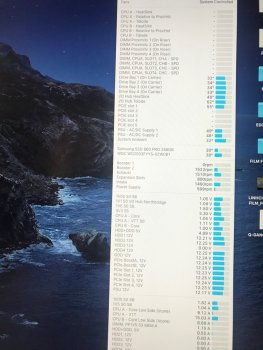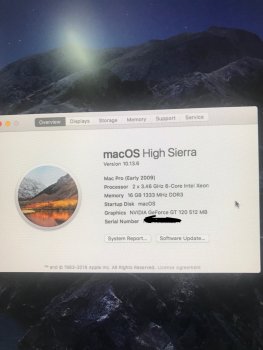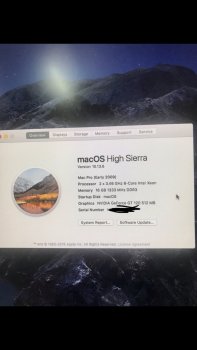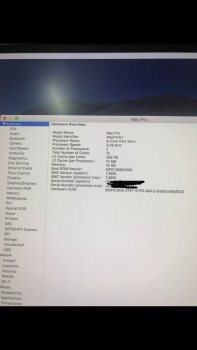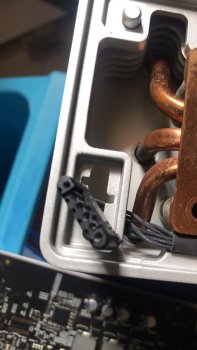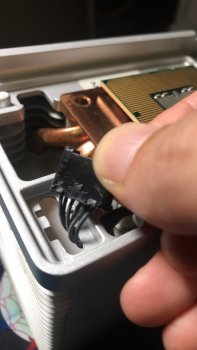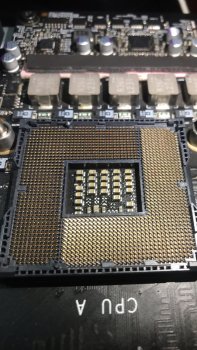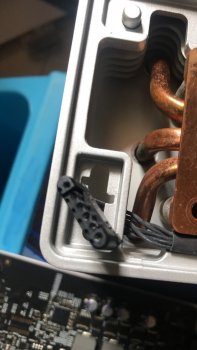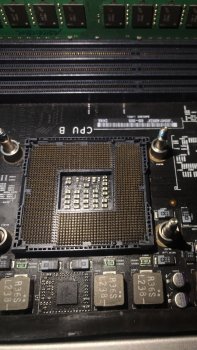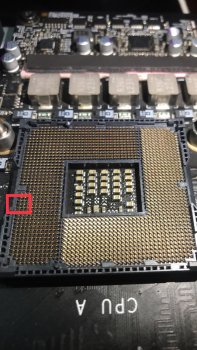I have upgraded Macpro 4.1 dual cpu 2.93 to two 3.46! The fan runs at full speed! There is no CPU thermal sensor. CPU A fan is not working (I checked it with my eyes and flashlight). Can someone help me! Thank you for your enthusiasm! These are the pictures I have!
Got a tip for us?
Let us know
Become a MacRumors Supporter for $50/year with no ads, ability to filter front page stories, and private forums.
MP 1,1-5,1 Help me! I am having problems upgrading my mac pro 2009 CPU!
- Thread starter Trungha
- Start date
- Sort by reaction score
You are using an out of date browser. It may not display this or other websites correctly.
You should upgrade or use an alternative browser.
You should upgrade or use an alternative browser.
did you update firmware?
Did you de-lid the processors?
Maybe the fan connectors in the heatsink have not engaged properly?
Did you de-lid the processors?
Maybe the fan connectors in the heatsink have not engaged properly?
Last edited:
Go to "About this Mac" then to "More info" tab .. . .copy the information in the first entry " Hardware" - paste that info here but blur your cMP serial number.
If you really want help in the mac pro forum. . go to your Macrumors member profile - go to " Signature " Make a 'Signature " to allow us to see your cMP's specs.
My 'Signature " is below, after this text at the bottom of this post.
If you really want help in the mac pro forum. . go to your Macrumors member profile - go to " Signature " Make a 'Signature " to allow us to see your cMP's specs.
My 'Signature " is below, after this text at the bottom of this post.
Thank You! My CPU is not Delid! I will check the connection of the heat sink!I did flash to 5.1did you update firmware?
Did you de-lid the processors?
Maybe the fan connectors in the heatsink have not engaged properly?
[automerge]1572354259[/automerge]did you update firmware?
Did you de-lid the processors?
Maybe the fan connectors in the heatsink have not engaged properly?
Thanks! This hereGo to "About this Mac" then to "More info" tab .. . .copy the information in the first entry " Hardware" - paste that info here but blur your cMP serial number.
If you really want help in the mac pro forum. . go to your Macrumors member profile - go to " Signature " Make a 'Signature " to allow us to see your cMP's specs.
My 'Signature " is below, after this text at the bottom of this post.
[automerge]1572354501[/automerge]
Thank You! My CPU is not Delid! I will check the connection of the heat sink!I did flash to 5.1
[automerge]1572354259[/automerge]
Thanks! This here
Attachments
Last edited:
you are on an older firmware version still but surely that cannot be the smoking gun here. It is plausible to think the connection for the fan in the heatsink did not make proper connection and therefore it will not spin up, so give that a close check if you haven't already. I'm not sure what to think about the unreported temps on the CPUs. Hopefully you have the original CPUs or whatever was installed prior to the X5690s? Put those back in and see if the behavior continues. If it goes away, reinstall the X5690's and perhaps they just were not seated good the first time around and work fine. If the issues comes back, then I think that points to the X5690's as having some problems
As someone that’s done this mod without de-lidding the processors, the fans will run full blast if one of the heat sinks is too loose.
Could be the fan on CPU A isn’t connected which triggers the other fans to run 100% because the system is trying to keep itself from melting.
Is it detecting all of your ram?
Are you using washers?
How did you measure the washers to use?
Did you trim the wire for the fan and attach it before tightening the heat sink?
You have two options:
1) go back to the original processors, make sure everything still works stock, then try the swap again.
2) try tightening the CPU A heat sink 1/8 of a turn at a time and see if the fan starts to work.
It’s nerve wracking, but if your slow and careful it will work out.
Could be the fan on CPU A isn’t connected which triggers the other fans to run 100% because the system is trying to keep itself from melting.
Is it detecting all of your ram?
Are you using washers?
How did you measure the washers to use?
Did you trim the wire for the fan and attach it before tightening the heat sink?
You have two options:
1) go back to the original processors, make sure everything still works stock, then try the swap again.
2) try tightening the CPU A heat sink 1/8 of a turn at a time and see if the fan starts to work.
It’s nerve wracking, but if your slow and careful it will work out.
Thank you! I have replaced the old cpu! The situation is still the same! I will reconsider the connection of the cpu heatsinkyou are on an older firmware version still but surely that cannot be the smoking gun here. It is plausible to think the connection for the fan in the heatsink did not make proper connection and therefore it will not spin up, so give that a close check if you haven't already. I'm not sure what to think about the unreported temps on the CPUs. Hopefully you have the original CPUs or whatever was installed prior to the X5690s? Put those back in and see if the behavior continues. If it goes away, reinstall the X5690's and perhaps they just were not seated good the first time around and work fine. If the issues comes back, then I think that points to the X5690's as having some problems
[automerge]1572401217[/automerge]
Thank you! Macpro got enough ram, I trimmed the fan connection cord! I use 2 thamepad to raise the washing machine! I tried tightening the washing machine! The results are still the same! With the old Cpu the status hasn't changedAs someone that’s done this mod without de-lidding the processors, the fans will run full blast if one of the heat sinks is too loose.
Could be the fan on CPU A isn’t connected which triggers the other fans to run 100% because the system is trying to keep itself from melting.
Is it detecting all of your ram?
Are you using washers?
How did you measure the washers to use?
Did you trim the wire for the fan and attach it before tightening the heat sink?
You have two options:
1) go back to the original processors, make sure everything still works stock, then try the swap again.
2) try tightening the CPU A heat sink 1/8 of a turn at a time and see if the fan starts to work.
It’s nerve wracking, but if your slow and careful it will work out.
[automerge]1572401560[/automerge]
This Thermpad I user!As someone that’s done this mod without de-lidding the processors, the fans will run full blast if one of the heat sinks is too loose.
Could be the fan on CPU A isn’t connected which triggers the other fans to run 100% because the system is trying to keep itself from melting.
Is it detecting all of your ram?
Are you using washers?
How did you measure the washers to use?
Did you trim the wire for the fan and attach it before tightening the heat sink?
You have two options:
1) go back to the original processors, make sure everything still works stock, then try the swap again.
2) try tightening the CPU A heat sink 1/8 of a turn at a time and see if the fan starts to work.
It’s nerve wracking, but if your slow and careful it will work out.
Last edited:
Yes!So even with the original CPUs the cpu a fan doesn’t work?
The first time I connected a CPU fan! 2cpu has no fan! Then I reconnected, only the CPU B fan, fan A stopped working (I tried with the old and new CPU)with the original cpu, are you sure that the cable for the cpu a fan is seated correctly?
So the fan connection is not like a traditional cable flopping around in there, it is secured so when the heatsink is pushed downwards the connection between the heatsink part and the part on the CPU board becomes interconnected. So basically if you seated the heatsink properly you connected the fan properly too. It's really obviously when you try to take the heatsinks off because with the screws loose the only thing that is holding it there besides any stickiness from the thermal paste is that CPU fan connection, I usually have to wiggle the heatsink around a bit to get that to disconnect
Did you have zero CPU temp stats populate with the original CPUs also? You might want to bust out a magnifying glass and investigate the pins in the CPU sockets if so. If the issues are occurring on the original CPUs also you could have something going on in the socket like a bent pin
PS - just noticed you wrote you did not delid these CPUs?!?!?
So please clarify for me, is both the original CPUs and new CPUs have the IHS on?
Or are the original CPUs delidded, and the new CPUs have the IHS on?
2009 system really needs the CPUs to be delidded. I guarantee this if your issue now if accurate. You are not making proper contact, it is going to be too forceful because you are sticking something bigger in a space designed for something smaller. You could have very likely damaged the socket doing this, even if you did the washer method
Did you have zero CPU temp stats populate with the original CPUs also? You might want to bust out a magnifying glass and investigate the pins in the CPU sockets if so. If the issues are occurring on the original CPUs also you could have something going on in the socket like a bent pin
PS - just noticed you wrote you did not delid these CPUs?!?!?
So please clarify for me, is both the original CPUs and new CPUs have the IHS on?
Or are the original CPUs delidded, and the new CPUs have the IHS on?
2009 system really needs the CPUs to be delidded. I guarantee this if your issue now if accurate. You are not making proper contact, it is going to be too forceful because you are sticking something bigger in a space designed for something smaller. You could have very likely damaged the socket doing this, even if you did the washer method
2009 system really needs the CPUs to be delidded. I guarantee this if your issue now if accurate. You are not making proper contact, it is going to be too forceful because you are sticking something bigger in a space designed for something smaller. You could have very likely damaged the socket doing this, even if you did the washer method
Plenty of people (myself included) have used lidded processors and the washer method. It is possible to do correctly without breaking anything. It is also easy to make a costly mistake and should be done carefully.
The Mac Pro uses a CPU diode temperature sensor to determine the CPU temperature. The fan speed is then adjusted based on that temperature reading. Low temperature results in low fan speed, and high temperature results in high fan speed.
If the computer cannot determine the CPU temperature, then to be safe it has to assume the CPU is hot and so runs the fan at full speed. This is what you are experiencing. So we know the Mac is not getting the CPU temperature reading.
Because this is happening with both the new and the original CPU in socket A, there are two possibilities I see:
If the computer cannot determine the CPU temperature, then to be safe it has to assume the CPU is hot and so runs the fan at full speed. This is what you are experiencing. So we know the Mac is not getting the CPU temperature reading.
Because this is happening with both the new and the original CPU in socket A, there are two possibilities I see:
- You have damaged one or more pins in socket A. This is one of the severe risks when using a lidded processor in a dual-CPU 2009. Closely examine the pins in the socket. If you can, take a high quality macro picture. Damage typically looks like a bent, scorched, or discolored pin.
- You have managed to incorrectly seat the CPU and heatsink, twice in a row (once with the new CPU, and then again with the original CPU). There are many stories here from people with a dual-CPU 2009 Mac Pro who have made slight adjustments (like 1/4 turn) on one or more heatsink screws, with various strange results like weird fan behavior, some memory slots not working, and even a CPU working or not. Tweaking the tension on the screws changed the behavior. If you have determined none of the socket's pins are damaged (scenario #1), then I'd try adjusting screw tension on the heat sink for CPU A (keeping in mind the following warning).
Last edited:
The Mac Pro uses a CPU diode temperature sensor to determine the CPU temperature. The fan speed is then adjusted based on that temperature reading. Low temperature results in low fan speed, and high temperature results in high fan speed.
If the computer cannot determine the CPU temperature, then to be safe it has to assume the CPU is hot and so runs the fan at full speed. This is what you are experiencing. So we know the Mac is not getting the CPU temperature reading.
Because this is happening with both the new and the original CPU in socket A, there are two possibilities I see:
Warning: Be extremely careful when tightening screws. Over-tightening screws WILL cause damage to the socket in a dual-CPU 2009, especially with lidded processors. One person said it happened even though he was using the washer method.
- You have damaged one or more pins in socket A. This is one of the severe risks when using a lidded processor in a dual-CPU 2009. Closely examine the pins in the socket. If you can, take a high quality macro picture.
- You have managed to incorrectly seat the CPU and heatsink, twice in a row (once with the new CPU, and then again with the original CPU). There are many stories here from people who have made slight adjustments (like 1/4 turn) on one or more heatsink screws, with various strange results like weird fan behavior, some memory slots not working, and even a CPU not working or not. Tweaking the tension on the screws changed the behavior. If you have determined none of the socket's pins are bent from scenario #1, then I'd try adjusting screw tension on the heat sink for CPU A (keeping in mind the following warning).
Yes, it definitely can happen.
+1 to checking the pins to look for damage.
Yes! It not working with the original CPUsSo even with the original CPUs the cpu a fan doesn’t work?
[automerge]1572486891[/automerge]
Old delid CPUs, new CPUs are still installed! I have reinstalled the old Cpus with nothing changed showing! I am suspicious of connecting CPU fan A! But if CPu B fan works, why can't I see the temperature measured in the app! Where can I buy CPU A fan separately for replacement! Thank you!So the fan connection is not like a traditional cable flopping around in there, it is secured so when the heatsink is pushed downwards the connection between the heatsink part and the part on the CPU board becomes interconnected. So basically if you seated the heatsink properly you connected the fan properly too. It's really obviously when you try to take the heatsinks off because with the screws loose the only thing that is holding it there besides any stickiness from the thermal paste is that CPU fan connection, I usually have to wiggle the heatsink around a bit to get that to disconnect
Did you have zero CPU temp stats populate with the original CPUs also? You might want to bust out a magnifying glass and investigate the pins in the CPU sockets if so. If the issues are occurring on the original CPUs also you could have something going on in the socket like a bent pin
PS - just noticed you wrote you did not delid these CPUs?!?!?
So please clarify for me, is both the original CPUs and new CPUs have the IHS on?
Or are the original CPUs delidded, and the new CPUs have the IHS on?
2009 system really needs the CPUs to be delidded. I guarantee this if your issue now if accurate. You are not making proper contact, it is going to be too forceful because you are sticking something bigger in a space designed for something smaller. You could have very likely damaged the socket doing this, even if you did the washer method
Last edited:
if your old/original CPUs are delidded, but new ones are not, then I assume you are removing/installing the washers and extra thermal pads everytime you make these CPU swaps?
i think a couple of us now have suggested to investigate your CPU socket(s). the symptoms you are describing can be related to damaged pin(s) in CPU socket(s). you should confirm this before trying anything else. i really think you damaged something during your upgrade, I just don't know anymore to guide you through finding out what could be damaged. Makes me wonder what you mean by "trimming the fan connection cord"? which certainly aligns with why a fan would no longer work if the cord is cut.
if the heat sinks are installed properly, the fans are connected properly. I have no idea where you will find any specific replacement part like that. these are a decade old system and practically nothing was off the shelf standard stuff. not necessarily impossible to find, and I don't believe proprietary is the right term, but certainly, "non-standard" would be the right term for something like the heat sink fans
i think a couple of us now have suggested to investigate your CPU socket(s). the symptoms you are describing can be related to damaged pin(s) in CPU socket(s). you should confirm this before trying anything else. i really think you damaged something during your upgrade, I just don't know anymore to guide you through finding out what could be damaged. Makes me wonder what you mean by "trimming the fan connection cord"? which certainly aligns with why a fan would no longer work if the cord is cut.
if the heat sinks are installed properly, the fans are connected properly. I have no idea where you will find any specific replacement part like that. these are a decade old system and practically nothing was off the shelf standard stuff. not necessarily impossible to find, and I don't believe proprietary is the right term, but certainly, "non-standard" would be the right term for something like the heat sink fans
He means that he modified the fan plugs in the heat sink.
If not they make no contact with undelidded CPUs.
Imho CPUs with Heatspreader on a Dual 4.1 is a nightmare. I have even seen some without washers :-(
When I get one on my bench I redo the upgrade if the sockets are not still damaged.
So to the TS: Inspect the sockets with a good optical instrument like a microskope or a good Camera with decent Macro.
If not they make no contact with undelidded CPUs.
Imho CPUs with Heatspreader on a Dual 4.1 is a nightmare. I have even seen some without washers :-(
When I get one on my bench I redo the upgrade if the sockets are not still damaged.
So to the TS: Inspect the sockets with a good optical instrument like a microskope or a good Camera with decent Macro.
thanks, I was wondering that was the case. the difference of IHS height preventing from the male/female connections from making a good connection. I chose to delid the handful of CPUs I put into dual 4,1s because of these type of troubleshooting headaches being common on mac forums. too bad they didn't just delid the CPUs and not have to mod all the other stuff, washers, thermal pads, fan connections, counting turns on screws, whatever else I don't know or remember about
It is difficult to tell what is going on. Please post a picture of:
- CPU A socket pins
- CPU A heatsink fan connector
Thank you all for the help! These are all the pictures I have!
Attachments
Hate to say it, but it looks like you bent about half the pins in Socket A, In the picture the right half all seem bent to the left. This is why I de-lidded my CPUs, IMO the amount of old thread lock left in the heat sinks makes tightening the things down sort of dangerous, since in my case it made it seem like they were tight to the CPU all the way until the end..
Sorry that happened to you. 😭
Sorry that happened to you. 😭
Hmm, dont see that so clearly, look at those horror pix:

 forums.macrumors.com
forums.macrumors.com

Mac pro 2009 CPU Socket damage
i have Mac Pro 2009 8 cores that i want to clean the pc and i take out the heatsink and put a new termal paste, i take out the processor and when i try to put the back i saw that some pins was damge - the pc now dont startup , when im powered on i see and hear the fans and the hdd but no...
Yeah, look at socket A the one with issues VS Socket B. All pins should be facing the same direction, in the picture of socket A they are not. He replaced de-lidded CPUs with CPUs with lids, the most common issue with lidded CPUs is bending pins, because the washers weren't thick enough or someone attempted to do it without washers.Hmm, dont see that so clearly, look at those horror pix:
Of course i could be wrong, but until Trungha confirms that it's just an illusion from the photo, it looks like one side of the heat sink was tightened too far and it bent the pins.
Last edited:
Register on MacRumors! This sidebar will go away, and you'll see fewer ads.


